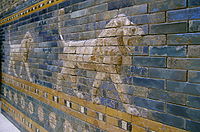Babylonian religion
It has been suggested that this article be merged with Assyro-Babylonian religion. (Discuss) Proposed since March 2010. |
| Part of a series on |
| Ancient Mesopotamian religion |
|---|
 |
|
|
Babylonian religion is the religious practice of the Babylonians, from the Old Babylonian period in the Middle Bronze Age until the rise of the Neo-Assyrian Empire in the Early Iron Age.
A brief revival of Babylonian religious tradition (as opposed to the closely related Assyrian) occurred under the 7th to 6th century Neo-Babylonian dynasty.
Mythology and cosmology
Babylonian mythology is a set of stories depicting the activities of Babylonian deities, heroes, and mythological creatures. These stories served many social, political, ceremonial purposes, and at times tried to explain natural phenomena. Babylonian mythology and religion was largely centered around civilization.
Babylonian mythology was greatly influenced by their Sumerian counterparts, and was written on clay tablets inscribed with the cuneiform script derived from sumerian cuneiform. The myths were usually either written in Sumerian or Akkadian. Some Babylonian texts were even translations into Akkadian from the Sumerian language of earlier texts, though the names of some deities were changed in Babylonian texts.
Many Babylonian deities, myths and religious writings are singular to that culture; for example, the uniquely Babylonian deity, Marduk, replaced Enlil as the head of the mythological pantheon. The Enûma Eliš, a creation myth epic was an original Babylonian work.

Religious Festivals
Tablet fragments from the Neo-Babylonian period describe a series of festival days celebrating the New Year. The Festival began on the first day of the first Babylonian month, Nisannu, roughly corresponding to April/May in the Gregorian calendar. This festival celebrated the re-creation of the Earth, drawing from the Marduk-centered creation story described in the Enûma Eliš.[1]
Importance of Idols
In Babylonian religion, the ritual care and worship of the statues of deities was considered sacred; the gods resided simultaneously in their statues in temples and in the natural forces they embodied. An elaborate ceremony of washing the mouths of the statues appeared sometime in the Old Babylonian period.
The pillaging or destruction of idols was considered to be a withdrawal of divine patronage; during the Neo-Babylonian period, the Chaldean prince Marduk-apla-iddina II fled into the southern marshes of Mesopotamia with the statues of Babylon's gods to save them from the armies of Sennacherib of Assyria.[2]
Influence on Abrahamic religions
Many of the stories of the Tanakh,[3] are believed to have been based on, influenced by, or inspired by the legendary mythological past of the Near East.
References
- ^ McIntosh, Jane R. "Ancient Mesopotamia: New Perspectives". ABC-CLIO, Inc: Santa Barbera, CA, 2005. p. 221
- ^ McIntosh, Jane R. "Ancient Mesopotamia: New Perspectives". ABC-CLIO, Inc: Santa Barbera, CA, 2005. pp. 35-43
- ^ Morris Jastrow Jr.; et al. "Babylon". Jewish Encyclopedia.
{{cite web}}: Explicit use of et al. in:|author=(help)
